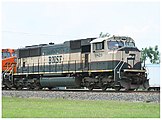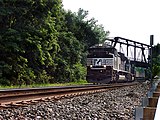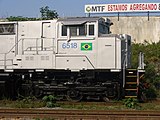|
EMD SD70 series
The EMD SD70 is a series of diesel-electric locomotives produced by the US company Electro-Motive Diesel. This locomotive family is an extension and improvement of the EMD SD60 series. Production commenced in late 1992[1][page needed] and since then over 5,700 units have been produced; most of these are the SD70M, SD70MAC, and SD70ACe models. While the majority of the production was ordered for use in North America, various models of the series have been used worldwide. All locomotives of this series are hood units with C-C trucks, except the SD70ACe-P4 and SD70MACH which have a B1-1B wheel configuration, and the SD70ACe-BB, which has a B+B-B+B wheel arrangement. Superseding the HT-C truck, a new bolsterless radial HTCR truck was fitted to all EMD SD70s built 1992–2002; in 2003 the non-radial HTSC truck (basically the HTCR made less costly by removing radial components) was made standard on the SD70ACe and SD70M-2 models; the radial HTCR truck remained available as an option. ModelsSD70 (1992–1999)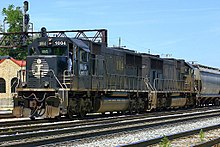 The EMD SD70 typically has the smaller spartan cab, typical on preceding SD60 models, instead of the larger comfort cab used on later models. Notable differences between the SD70 and SD60 are the radial steering EMD HTCR truck instead of the older HTC truck, and the SD70's overall length of 72 ft 4 in (22.05 m), with the older SD60 being 2 inches shorter. The SD70 also rides higher as its frame is approximately 1⁄2 inch (13 mm) higher than the SD60. This model is equipped with direct current (DC) traction motors, which simplifies the locomotive's electrical system by obviating the need for computer-controlled inverters (as are required for alternating current (AC) power). It is equipped with the 4,000 horsepower (3,000 kW), 16-cylinder EMD 710 prime mover. One hundred and twenty-two examples of this model locomotive were produced for Norfolk Southern (NS), Conrail (CR), Illinois Central (IC) and Southern Peru Copper Corporation (SPCC). Conrail's assets were split between Norfolk Southern and CSX in 1999, and all 24 of Conrail's SD70 units went to NS. Other than the CR paint scheme these units were built to NS specifications and numbered (2557 - 2580) in series with Norfolk Southern's already purchased SD70s. Production of the standard cab at EMD's London, Ontario plant ended in 1999. The 24 Conrail SD70s were assembled from kits at Conrail's Juniata Shops in Altoona, Pennsylvania, where the IC and SPCC SD70s were assembled from kits at Super Steel Schenectady. Most SD70s are still in service with Norfolk Southern and Canadian National (CN), which merged with Illinois Central in 1999. In February 2017, NS began a program to convert its SD70s from DC to AC, which will also have a new wide-nose cab, and several other upgrades. They will be designated as SD70ACC. SD70M (1992–2004) The SD70M has a wide nose and a large comfort cab (officially known as the "North American Safety Cab"), allowing crew members to ride more comfortably inside of the locomotive than the older standard cab designs. There are two versions of this cab on SD70Ms: the Phase 1 cab, which was first introduced on the SD60M, and the Phase 2 cab, which is a boxier design similar to the original three-piece windscreen on the SD60M, which is shared with the Phase 2 SD90MAC, SD89MAC, and SD80ACe. The Phase 2 cab has a two-piece windscreen like the Phase 1 windscreen but the design of the nose is more boxy, with a taller square midsection for more headroom. The SD70M is equipped with D90TR DC traction motors and the 710G3B prime mover.[2][page needed] They are capable of generating 109,000 lbf (480 kN) of continuous tractive effort.[2][page needed] From late 2001, the SD70M was produced with SD45-style flared radiators allowing for the larger radiator cores needed for split-cooling. Split-cooling is a feature that separates the coolant circuit for the prime mover and the circuit for the air pumps and turbocharger. There are two versions of this radiator: the older version has two large radiator panels on each side, and the newer version has four square panels on each side. This modification was made in response to the enactment of the United States Environmental Protection Agency's (EPA) Tier 1 environmental regulations. Also the truck was replaced with HTCR-4, instead of HTCR-I on former model. Production of the SD70M ceased in late 2004 as production of the SD70M-2 model began (the EPA's Tier 2 regulations went into effect on 1 January 2005). 1,609 examples of the SD70M model were produced. Purchasers included New York, Susquehanna & Western (NYSW; part of EMDX order no. 946531[3]), Norfolk Southern and Southern Pacific (SP; now part of the Union Pacific Railroad), but the vast majority were purchased by Union Pacific. In 2000, an order of SD70Ms made history when Union Pacific ordered 1000 units of the model (UP 4000 through UP 4999, inclusive, although 4014 was renumbered 4479 to accommodate Big Boy 4014 in 2019[4]). This order was later extended by nearly 500 additional units (UP 3999 and below, UP 5000 and above, except for 3985, which was left vacant for Challenger 3985). This locomotive model is also built for export, and is still catalogued by EMD (at 4,300 hp or 3,200 kW). CVG Ferrominera Orinoco has 6 SD70Ms that were built as an add-on order to UPs FIRE cab equipped SD70Ms. Companhia Vale do Rio Doce (CVRD) in Brazil has ordered 55 of this model for service for the Carajás mine pulling trainloads of iron ore. Since CVRD track is gauged at 1,600 mm (5 ft 3 in), a wider bogie, the HTSC2, was designed for these units by EMD.[5] SD70I (1995)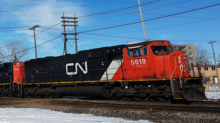 The SD70I is a version of the SD70 which has been fitted with a cab that is isolated from the frame of the locomotive with rubber gaskets (officially known as a "WhisperCab"). The isolation reduces noise and vibration from the prime mover. A seam is visible across the nose and on the long hood where the cab connects with the body. 26 examples of this model locomotive were produced, all for Canadian National. The WhisperCab feature was incorporated into some SD70MACs and was standard on both the SD80MAC and SD90/43MAC models. SD70MAC (1993–2007) The SD70MAC uses three phase AC traction motors. Production of the model commenced in 1993, competing against the GE AC4400CW. The majority of SD70MAC models were produced with the 4,000 horsepower (3,000 kW) EMD 710 prime mover while later units are rated at 4,300 horsepower (3,200 kW) and feature EMD SD45-style flared radiators.[citation needed] Starting in 1993, the Alaska Railroad ordered SD70MACs with head-end power to make them suitable for both freight and passenger service; no other railroad ordered this variant. Due to the Alaska Railroad's satisfaction with these locomotives, they specially ordered additional models after EMD had transitioned production to the SD70ACe.The last order of Alaska Railroad SD70MACs was built/delivered in late 2007.[6][7] The trucks were replaced with HTCR-4, instead of HTCR-I on former model.[citation needed][clarification needed]  The SD70MAC is no longer produced due to EPA regulations, and was replaced by the SD70ACe in 2004. In total, 1,109 SD70MACs were produced, purchased by Burlington Northern (and its successor, BNSF), Conrail, CSX, Transportación Ferroviaria Mexicana (TFM; units now owned by Kansas City Southern Railway (KCS)), and the Alaska Railroad. SD70ACe (2004–present) The SD70ACe is the successor to the SD70MAC with design changes to comply with emission standards. The engine fires with 15% lower internal pressure to improve emissions and features fewer internal components in the inverter.[8] The SD70ACe is equipped with EMD's 16-710-G3C-T2 prime mover, rated at 4,300 horsepower (3,200 kW); later Tier 3 models are rated at 4,500 horsepower (3,400 kW), and have a thermal efficiency of almost 36%.[9] They are rated at 157,000 lbf (700 kN) continuous tractive effort (191,000 lbf (850 kN) starting). Braking effort is rated at 106,000 lbf (470 kN). Early models featured a bad cab design which was noticed first on CSX as crews reported annoying disturbances such as prime mover noises, traction motors and more. The cab was also known for rattling, leading to the nickname "Thundercabs". As a result, these units are also not approved for leading trains.[9] In 2012, EMD also built four models known as the SD70ACe-P6. These units, unlike previous SD70ACe's, have one inverter per axle on the trucks, rather than EMD's traditional one inverter per truck design. Four of those ( EMDX 1206, 1208, 1209 and 1210) were sold to Canadian National Railway and renumbered to CN 8100–8103.[citation needed] In 2014, BNSF Railway took delivery of 20 SD70ACe-P4 units, numbered 8500 - 8519. This model was designed with a B1-1B wheel arrangement to compete with GE's ES44C4 model, which has an A1A-A1A wheel arrangement. Both wheel arrangements mean that there are only two traction motors per truck instead of three, those being the ones next to the fuel tank. Two SD70ACe-P4 demonstrators began a 5-year lease at Tacoma Rail in late 2014, and were later sold to Arkansas & Missouri Railroad in late 2023. On January 1, 2015, the United States Environmental Protection Agency's Tier 4 locomotive emission regulations went into effect. EMD could not successfully modify the SD70ACe's 2-stroke 710 series prime mover to be Tier 4-compliant; thus, the Tier 3 SD70ACe was succeeded by the SD70ACe-T4 in late 2015. However, US production of the Tier 3-compliant SD70ACe continues with Tier 4 'credit units' (new Tier 3-compliant units EMD is entitled to build based on previously earned emissions credits). Union Pacific and Norfolk Southern are currently the only US roads to own Tier 4 credit unit SD70ACe's. Additionally, EMD has continued building Tier 3 SD70ACe's for Ferromex (4100–4118), Ferrosur (4119–4133), and Kansas City Southern de Mexico (4200–4224) at Bombardier Ciudad Sahagun. These locomotives are restricted to Mexico-only operation and cannot cross the US border (just as Canadian National's newest Tier 3 GE ES44AC's are restricted to Canadian use only).[citation needed] In March 2016, EMD replaced the standard cast HTCR-4 trucks on NS SD70ACe 1000 with the new fabricated HTCR-6 trucks for testing. UP and BNSF plan to test the new HTCR-6 trucks on some of their SD70ACe units also. Union Pacific received 281 additional SD70ACe units, numbered 8824 - 9104, in 2014, 2016 and 2018. These are referred to as SD70AH (T4C), H for "heavy", because they are ballasted to 428,000 lb (194,138 kg) rather than 420,000 lb (190,509 kg). 2TE3250 (2021)In mid-2021, the Yakutian Railway received two SD70ACes, designated 2TE3250 (Russian: 2ТЭ3250) by Yakutian Railway itself. These units, numbered 0001 and 0002, are currently in use in Yakutia, and are operated as a two-section locomotive.[10][11] In November 2021, Yakutian Railway announced a tender for 6 more, single-section locomotives.[12] However, as of 4 February 2022, it has been unable to make an order for them.[13] SD70M-2 (2004–2011) The SD70M-2 is a DC traction version of the SD70ACe. The "-2" in the model name indicates that the units are EPA Tier II compliant and that the locomotive has upgraded electronics, which was true for older models (EMD SD40-2).[14] SD70M-2 models are equipped with the 16-710G3C-T2 or 16-710G3C prime mover which is rated at 4,300 horsepower (3,200 kW).[15] In total, 331 SD70M-2s were built, with Canadian National owning 190 units. Eight units owned by Electro-Motive Diesel and four units owned by CIT Financial were leased by Florida East Coast Railway until early 2015. Canadian National 8964 was the last SD70M-2, built in February 2011. Vermont Railway owns 2 units numbered 431 and 432. Norfolk Southern ordered 130 SD70M-2s, of which 46 remained in service as of July 2023 with 2 units rebuilt with AC traction.[16][17][18] Currently, NBM Railways owns 13 SD70M-2, former NS units, numbered 6401–6413 with plans for six more rounding it out to 6419. All are marked for the various NBM companies, New Brunswick Southern Railway, Eastern Maine Railway, and Maine Northern Railway. SD70ACe-T4 (2015–present) The SD70ACe-T4 is the Tier 4 emissions standards-compliant successor of the SD70ACe. The first locomotive, EMDX 1501, was built in summer 2015, and made its debut at the Railway Interchange Expo in Minneapolis, Minnesota during the weekend of October 3–4, 2015. It features a new 4-stroke engine called the EMD 12-1010 "J" series - a V12 with 1,010 in3 displacement for each cylinder. This new prime mover has a two-stage turbocharger system consisting of three turbos; one turbo (the primary/high pressure turbo) for low-mid RPM and two turbos (the secondary/low pressure turbos) for mid-high RPM. The results of this setup are higher power throughout a broader RPM range, better fuel efficiency, and lower emissions. An EGR system is applied as well, allowing the engine to achieve Tier 4 without the use of urea aftertreatment. Another new feature of this engine is the Double-Walled Fuel Injection System that increases safety and provides simplified maintenance works. The EMD 12-1010 is capable of producing 4,600 horsepower (3,400 kW) total, 4,400 horsepower (3,300 kW) is used for traction.[19] With a new computer software for the on-board computer and one inverter per axle (or "P6"; EMD named it "Individual Axle Control") - unlike most of previous EMD locomotives that use one inverter per truck, the SD70ACe-T4 is capable of generating 200,000 pounds-force (890 kN) of starting tractive effort, and 175,000 pounds-force (780 kN) of continuous tractive effort. Meanwhile, its dynamic braking effort is as much as 105,000 pounds-force (470 kN). The amount of starting tractive effort is equal to that of the 6,000 horsepower (4,500 kW) SD90MAC-H while, on the other hand, its continuous tractive effort is higher than that of the SD90MAC-H (175,000 pounds-force (780 kN) vs. 165,000 pounds-force (730 kN)). The units are also equipped with "radial bogies" which offer increased adhesion and better ride quality.[19] While it retains the basic SD70 designation, the locomotive has several major new features that set it apart from its successful ancestor such as a vibration-isolated powertrain, and alternator start capability. In addition, it features a newly redesigned cab reminiscent of the earlier SD70M, featuring the classic "teardrop" windshields first introduced on the FP45 in December 1967; new fabricated trucks; a longer frame at 76 feet 8 inches (23.37 m); longer radiators with three radiator fans instead of two; an additional step on the front and rear; and a smoother long hood roofline.[20][21][22][23] Fifteen SD70ACe-T4 demonstrators were built at Muncie, Indiana by November 2016. Union Pacific was the first customer to order SD70ACe-T4's. UP 3012–3014, the first production SD70ACe-T4's, were assigned to active service in early November 2016. Union Pacific acquired 100 SD70ACe-T4's: 12 former demonstrators rostered as UP 3000–3011, and 88 production units (3012–3099). 3012-3056 were built at Bombardier's Sahagun, Mexico plant. 3057-3099 will be built at Muncie, IN, following completion of the Tier 4 credit SD70ACe's UP 8997–9096. All UP SD70ACe-T4's are classified as SD70AHs. SD70ACeP4-T4's EMDX 1603 and 1604 were built and painted as demonstrators for the BNSF Railway. These units have a B1-1B wheel arrangement akin to the SD70ACe-P4. In August 2018, CSX Transportation ordered 10 SD70ACe-T4's. They were classified by CSX as ST70AH. In July 2023, CSX Transportation sidelined their ST70AH locomotives due to the leasing agreement being expired. All 10 have been taken back to PRLX and will more than likely be used as parts or on the lease fleet. Norfolk Southern originally ordered 10 SD70ACe-T4's, but opted for more SD70ACe Tier-4 credit locomotives instead. The cancelled units are currently part of the Progress Rail lease fleet. EMDX 1501 will remain in Progress Rail Services ownership as a test bed. SD70ACe/LCi (2005–present) The SD70ACe/LCi is a low clearance, export version of the SD70ACe. The LCi in the model designation stands for Low Clearance international as these locomotives are designed to negotiate the tight clearances under the mine equipment. External differences between the SD70ACe and SD70ACe/LCi models include the addition of marker lights, number boards located lower on the nose rather than on top of the cab, windscreen protector panels (to deflect abrasive iron ore when in mid train position), fire suppression canisters, louvre style vents, different horn and subtle differences with handrails.[24][page needed] In 2004, BHP Billiton ordered 14 SD70ACe/LCi locomotives for use on iron ore trains in the Pilbara region of Western Australia.[25] The first member of the class (4300) was purchased for parts and dismantled upon arrival in Australia. This was because it was cheaper to purchase a complete locomotive than buy the components individually.[26][27] They were named after sidings on the BHP system.[24][page needed][28] Since they did not have the newer, isolated cab of the second and subsequent batches, 4301–4313 were traded in to Progress Rail for locomotives with newer cab assemblies and repatriated to the United States in January 2015 being taken to Muncie, Indiana for store.[29] They were overhauled and sold to Chemin de fer Arnaud (4), Montana Rail Link (4) and Quebec North Shore & Labrador (5).[30] BHP operated in 2015 a fleet of 23 SD70ACe/LCi locomotives beside of 142 standard SD70ACe, from which the newest locomotives are built in 2014.[31] The second batch of 10 SD70ACes (4314–4323) arrived between August and November 2006. An order for a third batch of 13 SD70ACe/LCi's (4334–4346) was placed in August 2007, but such was the demand for locomotive power in the Pilbara region, a deal was done with BNSF for BHP Billiton to purchase ten standard North American SD70ACes (4324–4333) that were in build as their 9166, 9167, 9184–9191. Construction was sufficiently advanced when the deal was concluded for them to have been painted, hence they were delivered in BNSF orange livery. Some modifications have been made to bring them in line with the rest of the fleet. A fifth batch of SD70ACes (Numbers 4347–4355) was delivered in July 2009.[24][page needed][26] An additional 18 units (numbers 4356–4373) were delivered in the second half of 2010, bringing the total of SD70ACe type locomotives in service to 72.[27] In March 2012, BHP Billiton ordered a further 80.[32] As at October 2020, BHP operated 10 SD70ACes (4324–4333) and 174 SD70 Ace/LCis (4314–4323, 4334–4497)[33] In July 2012 fellow Pilbara operator, Fortescue Metals Group, took the delivery of the first of a fleet of 19, later extended to 21 (701–721).[27][34][35] SD70ACS (2009–present) The SD70ACS is a 4,500 horsepower (3,400 kW) AC variant for heavy haul freight, used in desert environments. The first 25 units were ordered for Saudi Railway Company in April 2009 and assembled in the London, Ontario, plant for delivery in the second half of 2010. Special features include a pulse filtration system, movable sand plows, EM2000 control system and FIRE display system.[36] Mauritania's Société Nationale Industrielle et Minière placed a contract for six SD70ACS locomotives in October 2010.[37] In July 2011 Etihad Rail ordered seven SD70ACS locomotives for delivery in 2012.[38] Seven locomotives were delivered in 2013.[39] SD70ACe-BB (2015–present)In October 2015, EMD started producing SD70ACe-BB locomotives for Brazilian 1,000 mm (3 ft 3+3⁄8 in) railroads.[40] Unlike the standard SD70ACe, the SD70ACe-BB has a B+B-B+B wheel arrangement, meaning that it has eight axles instead of six. To fit the B+B trucks, the SD70ACe-BB was elongated to 74 ft 9 in (22.78 m), making it 2 ft 5 in (0.74 m) longer than the standard SD70ACe. SD70ACe/45 (2004–present) The SD70ACe/45 is a diesel-electric locomotive built by EMD plant in Sete Lagoas, MG Brazil. Different from the SD70ACe in North America, the SD70ACe/45 has a longer frame (76 ft. 6 in.) and three radiator fans on the radiator section since it uses the same car body of the SD80ACe produced by EMD plant in London, Canada to Vale mining in Brazil. It uses 1,600 mm (5 ft 3 in) gauge. 80 SD70ACe/45s had been built.[41] SD70IAC (2019–present)In early 2019 with the delivery of the new SD70ACe-T4C locomotives to Norfolk Southern, a new type of the T4C (Tier 4 Credit) locomotives was rolled out of Progress Rail in Muncie, Indiana. IAC stands for Individual Axle Control. They are still classified as SD70ACe's on the side of the locomotive but are designated as SD70IAC within the cab controls. The new IAC system improves the existing traction system. SD70ACe/LW (2007, 2021–present)The SD70ACe/LW is designed specifically for rail networks using Russian gauge, featuring a new isolated cab similar to the flat nosed cab of the GT46C-ACe Gen-II. The SD70ACe/LW has a 16-710G3C-T2 prime-mover with 4,500 horsepower. It uses an AC traction system with a top speed of 74 mph (120 km/h).[42] Although it was designed in 2007, the first orders only occurred in mid-2021, when 16 were purchased for the Mongolian Tavan Tolgoi-Gashuunsukhait Railway project.[43] RebuildsSD70ACU   The SD70ACU is a rebuild performed by Norfolk Southern and Progress Rail Services. It is originally an SD90MAC (or better known as a SD9043MAC) that has been rebuilt to replace its Siemens electrical components with equipment from Mitsubishi and replace the cab with the new EMD Phase-II cab to comply with the most recent safety requirements.[44] 100 of the 110 units Norfolk Southern purchased were originally SD9043MACs previously operated by Union Pacific.[44] The other 10 units were acquired by a trade with Cit Group for MP15DCs.[citation needed] All NS-owned SD9043MACs were rebuilt by NS at its shops in Altoona, Pennsylvania.[citation needed] The first locomotives were released from the shop in January 2016.[44] By May 7, 2019, all 110 SD70ACU units owned by Norfolk Southern were completed and released to active service.[citation needed] 46 of these were sold in November 2020 with 30 of them going to Ferromex in 2024.[citation needed] Canadian Pacific has also begun a program to convert their SD90MAC units into SD70ACUs, but unlike Norfolk Southern, Progress Rail is performing the rebuilds.[45] The initial order was for 30 units and then increased to 60.[46] Canadian Pacific originally rostered 61 SD90MACs, which spent much of the 2010-decade parked in long-term storage, with the exception of three, which were retired and scrapped in 2012.[citation needed] The remaining 58, along with two surplus Union Pacific SD90MACs, will be used as cores for the 60 SD70ACUs. These units began delivering in 2019.[46] From this order came numerous heritage units. Namely: CP 7010-7014 in CP's tuscan red, gray, and gold paint scheme with script lettering, CP 7015-7019 in the same paint but with block lettering,[47] CP 7020 in NATO green representing temperate climates, CP 7021 in the sand color used for arid climates, CP 7022 wears the grey, red and black colour pattern of modern warships, CP 7023 wears a two-tone gray paint scheme inspired by fighter jets, CP 6644 wears the camouflage colours applied to Royal Canadian Air Force “Spitfire” fighter planes flown at the Allied invasion of Normandy, France, on June 6, 1944 and is numbered in remembrance of that date.[48][49] CP 7015 led the CP business train for a short time due to a mechanical failure with the regular units and then returned to freight service.[50][51] The remaining units received the standard CP red paint scheme. In 2021, Canadian Pacific purchased 40 more SD90MACs from the Union Pacific for further rebuilding into SD70ACU engines.[citation needed] SD70ACCThe SD70ACC is the latest rebuild in Norfolk Southern's DC to AC program. It has the new EMD safety cab, similar to the SD70ACe cab, but with the “teardrop windshield”, much like the SD70ACe-T4. The SD70ACC has been rebuilt with AC traction motors, an AAR-style control stand, an electrical cabinet with Mitsubishi electronics, a new main alternator, and additional weight to increase the maximum weight to 432,000 pounds (196.0 t). The SD70ACC is rated at 4,500 horsepower (3,355.649 kilowatts), has a fuel capacity of 4,900 US gallons (19,000 L), and has dynamic braking, cab signals, and LSL (Locomotive Speed Limiter).[citation needed] The first locomotive was released to service in November 2018.[52] Norfolk Southern is rebuilding its fleet of SD70s into SD70ACC specifications.[53][54] The first two units, 1800 and 1801, were unveiled in a special yellow and grey paint scheme to promote the DC to AC program, similar to the paint schemes used on the first GE AC44C6M. As of 2024, Only 52 Units have been rebuilt and have since been released to service.[55] SD70MACeThe SD70MACe is a rebuilt SD70MAC locomotive with new Mitsubishi electronics and traction motors to replace the Siemens traction motors, first rebuilt for the BNSF Railway,[56] and later rebuilt for CSX (classified as SD70AC) and KCS. SD70MACH The SD70MACH is an SD70MAC rebuilt by Progress Rail for Metra. The rebuild also includes the addition of head end power (HEP) along with meeting Tier 3 emissions. Metra has approved of a purchase of 15 SD70MACHs for passenger service, with options of up to 27 more.[57] They are the first six-axle passenger locomotives since the EMD F40C and the Alaska Railroad's HEP-equipped SD70MACs. The axles are configured in a B1-1B configuration as one inverter is repurposed for supplying HEP.[58] The first unit was delivered in 2022 and entered service in late 2023.[59] SD70ICCThe SD70ICC is an SD70M-2 rebuilt with AC traction by Progress Rail. Units are rebuilt from Norfolk Southern & PRLX SD70M-2's. Norfolk Southern is currently the only operator of these units.[60] Operators
PreservationOn November 8, 2019, Union Pacific donated SD70ACe No. 4141 to the George H.W. Bush Presidential Library and Museum.[83] The locomotive, painted in honor of George H. W. Bush, was unveiled in October 2005 and was in active service until 2009, when it was placed into storage due to the financial crisis of 2007–2010. It was brought back in 2018 to participate in Bush's funeral train on December 6, 2018.[84] The locomotive subsequently remained in active service following the funeral until its last run between November 8 and November 9, as part of the Union Pacific 4014 Southwest Tour, in which the plans for the display were unveiled. The locomotive arrived back at College Station on March 12, 2021,[85] and the Marine One/4141 Locomotive Pavillion, where the 4141 is displayed, opened on June 13, 2024.[86] Gallery
Footnotes
References
Further reading
Wikimedia Commons has media related to EMD SD70 series. |
||||||||||||||||||||||||||||||||||||||||||||||||||||||||||||||||||||||||||||||||||||||||||||||||||||||||||||||||||||||||||||||||||||||||||||||||||||||||||||||||||||||||||||||||||||||||||||||||||||||||||||||||||||||||||||||||||||||||||||||||||||||||||||||||||||||||||||||||||||||||||||||||||||||||||||||||||||||||||||||||||||||||||||||||||||||||||||||||||||||||||||||||||||||||||||||||||||||||||||||||||||||||||||||||||||||||||||||||||||||||||||||||||||||||||||

